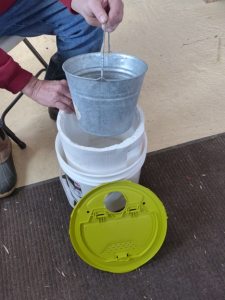Like humans, chickens enjoy sipping cool refreshing water. They drink a surprising amount, even in winter, and it’s essential that they always have it available.
There’s a problem. Winter! When the temperature plunges below freezing water soon becomes ice. A chicken’s beak is a versatile organ able to snatch up even the tiniest morsel, but it can’t chip a hole in the ice to get a drink or substitute snow for water. Fortunately, there are ways to keep water liquid through the nastiest cold spell.
Old Fashioned Bucket Brigade
Buckets are the age-old way to water the flock, but buckets freeze fast. Anyone willing to carry a fresh bucket of warm water out to the coop every couple of hours and retrieving the icy one has solved the problem. Today most people are at work or school all day and can’t frequently deliver water. They need a solution that will prevent freezing for many hours.
The Best Solution
By far the most convenient way to keep liquid water in the coop is to use one of many types of electrically heated waterers available wherever chicken supplies are sold. Pet stores sell heated dog dishes that also work well with chickens, especially if they are placed in an elevated cradle made of scrap wood to keep hens from tipping it over or scratching litter into clean water.
In the long run paying an electrician to run power into the coop is an investment in convenience that enables lighting and keeping water ice free.
Making a Frost Resistant Waterer
There’s a partial solution for those who don’t have electricity in their coop. It’s making a frost resistant waterer. Here’s how:
- Buy a winter bait bucket at a store that sells ice fishing equipment. These are made to keep an angler’s minnow bait from freezing. They are a bucket within a bucket. The outer one is a rigid plastic pail with a tight-fitting lid, usually with a flip top built in. The inner bucket is made of Styrofoam, an excellent insulator.
- Remove the lid. Use a saber saw to cut a hole of two or three inches in diameter from near the plastic lid’s edge. It’s usually easiest to first drill a quarter inch hole for the saw blade to enter. Sometimes cutting the hole with a knife works. Just be careful.
- Buy a small metal or rubber pail that fits inside the Styrofoam insulated pail. An eight-quart bucket works perfectly.
- Put the inner bucket inside the Styrofoam bucket and both into the outer hard plastic pail. Snap the lid on tightly.
- Fill the frost resistant bucket with lukewarm water and place it in the coop. Chickens will drink through the hole you’ve cut into the lid.
A frost resistant bucket will still freeze, but the Styrofoam insulation keeps the water liquid much longer than a plain bucket, reducing the number of trips to the coop. Chickens love to peck at Styrofoam, so make the contraption in a way that they can’t access the soft white plastic insulation. It’s important for both people and chickens to stay hydrated, so be sure to always keep fresh, clean, liquid water in the coop.
